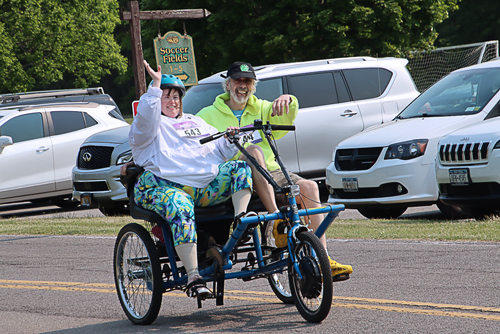Featured News - Current News - Archived News - News Categories
By Liam Cuddy
Special to NFP
What comes to mind when you hear "summer body"? Most people think of a sleek, toned, healthy human being, be it male or female. It's natural to want this kind of body, not only because it is found attractive to be physically fit in modern day American culture, but also because it is healthy. Being physically fit not only increases health benefits, it also increases mood and confidence, as well.
Lets face it: Working out sucks. It really, really does. But that doesn't mean it is impossible. With the right timing and determination, you can achieve your summer body in about a month! All you need is a little gym time education, and dedication to the program you choose to pursue.
First, let's start with diet. Diet is and always has been a topic of much discussion and debate. The reason I say this is because one can make a diet out of absolutely anything. That's right, absolutely anything.
Diet has many stereotypes, the biggest of which is that dieting means "losing weight." Well, sure, a lot of dieting is centered around losing weight, but if that's all you're trying to do, boy do we have news for you! You can diet with absolutely anything. And yes, I mean anything.
Here is a list of some of the weirder diets out there...
Dieting to lose weight can be done with any food you can imagine. You just have to remember that, just because these diets will help you lose weight, doesn't mean they are healthy by any standards. Dieting comes down to one simple premise: calories in, versus calories out. That mean you need to outsmart your body's basic metabolic rate. Yes, that may seem complicated, but it's really just as simple as eating less calories than you burn. As humans, we are burning calories at a rapid pace throughout the day.
Everything we do burns calories: walking from class to class, hashing out a difficult math problem, or even reading this article burns calories. Calories are the standard units of energy that we obtain through eating food. Calories can be found in fats, sugars, proteins, all of the essential vitamins, etc. They are literally in every food we eat. So, if your main goal is to just cut weight, you need to figure out how many calories your body takes in every day to maintain a healthy balance. Once you have that figured out, all you need to do is gradually adjust your diet so that you are getting less calories.
Yet skinny does not mean healthy. Fit means healthy. And in order to get fit, we need to have a healthy balance of cardio and weight training, along with proper intake of key nutrients that can be obtained through everyday foods and vitamins.
Fat Burning: When it comes to burning fat, there is no better cure than a little cardio. Cardio is short for "cardiovascular," which is the term associated with blood flow to and from the heart, and throughout your body. Cardio is a very simple, yet sometimes difficult process. The simplicity comes with the act of doing it.
My personal favorite form of cardio would be running. I like to lace up my sneakers, go for a nice, 30-minute jog, and call it a day. But there are many other ways to get your daily cardio. The trick for fat burning through cardio is to go at a 30 percent pace for at least 30 minutes. Studies have found that keeping your heart elevated for over 30 minutes triggers the fat-burning process in your body, so it works as quick and effective as possible.
When it comes to weight lifting, a popular tactic is the process referred to as "high intensity interval training," or HIIT.
Brett Adams an experienced physical trainer who is well studied in both kinesiology (the study of human body movement) and exercise science.
"HIIT is a very effective method of workout, increasing fat burned, metabolic increase, endurance, and muscle retention and increase," he said. "It stands for high intensity interval training, and is exactly that. It can be applied to any style workout from cardio to weights. You have set intervals that you make up, usually shorter periods, however, and give a high effort for that time. Then have a rest, hence the interval side of things. It is very effective at increasing metabolic rate and burning a large amount of calories in a shorter amount of time. Not only that, but it will keep your metabolism elevated for the next 24-36 hours, so your metabolism would be higher than if you were to just do standard cardio."
Gaining Muscle: Gaining muscle is a whole other beast. When one tries to gain muscle, they are supposed to minimize cardio drastically, because muscle growth is the most effective when there is an excess of calories in the body. According to bodybuilding.com, extra calories can go one of three ways: They can be excreted in waste, they can be stored as fat, or they can help support muscle growth. When it comes to dieting during this process, it is important that the person gets an ample amount of both protein and amino acids, both essential building blocks for muscle.
The workouts for gaining muscle differ from the HIIT program mentioned previously in this article. Workouts for gaining muscle should consist of heavier weight, and less reps. So, instead of shooting for 8-10 reps, try going for 6-8. It is also important that, after you are through with your workout, to do 6, 15-second sprints. These sprints will help turn unused carbohydrates in your body into muscle, as opposed to fat.
Diet: As stated previously, diets can consist of everything. However, a diet for a healthy body has all the essential food groups in each meal. Wacky, far-out diets can work, but are extremely difficult to stay on top of and maintain, and usually result in others reverting back to there previous state or worse.
"Slow and steady is the way to go," Adams said. "There is no need to make large, dramatic changes all at once. Keep a balanced and healthy diet and lifestyle. There is a reason they are called 'yo-yo diets.' You cannot sustain them and then you tend to rebound after depriving yourself for so long. Eat a little less for dinner, or cut out the junk food at first. Small pieces make a huge difference over time. And I am not talking about 'trying' to cut things out."
Diet also has a way of tricking us. In other words, our bodies don't really like drastic change, that's why it is so important to slowly adjust.
"One day you might eat a little less than normal," Adams said. "Your body knows this and makes you extra hungry the next day to make up for that calorie deficit you had the day before. You just will not realize it and eat until that fullness hits. It's sneaky like that. It likes to keep itself even on a week-to-week basis."
•Breakfast: Hefty serving of protein (eggs), small serving of fats (sausage or bacon), and a carbohydrate or starch (oatmeal, potato or toast).
•Lunch: Serving of lean meat or fish (chicken or fish), serving of starch, and any vegetables you can get!
•Dinner:Serving of lean meat, serving of starch, and any vegetables you can get!
•Dessert: Completely optional.
•Extra snacks can include nuts and fruit to keep you alert and focused throughout the day.
Now that you have the very basic foundation for how to get the body you want, get out there and have a good time. It is important that you make it fun, or else it will become a chore, and you will lose the motivation you need to succeed.
Don't let the scale scare you away. Weight gain throughout this process is common and often due to the gaining of muscle. Remember that muscle weighs more than fat.
Good luck and have fun on your journey to the better you.





























